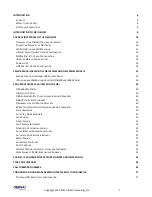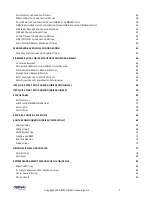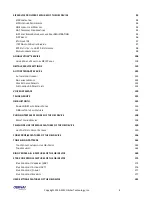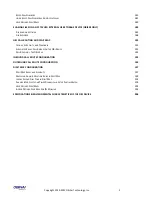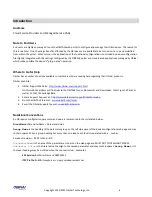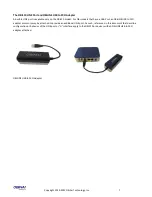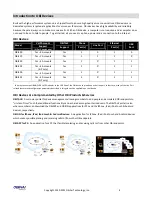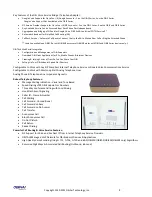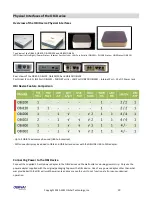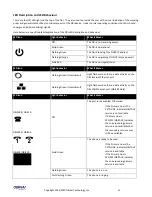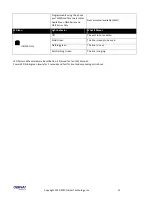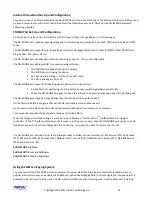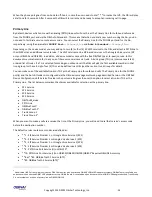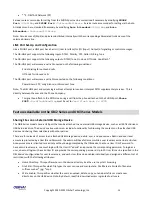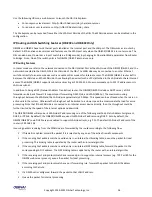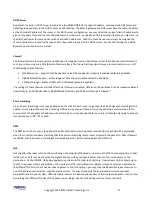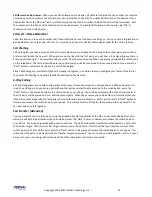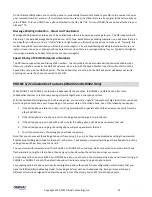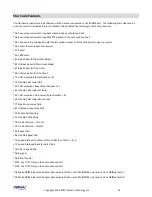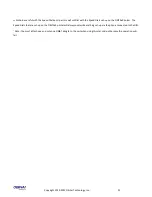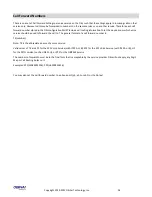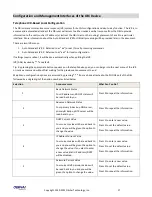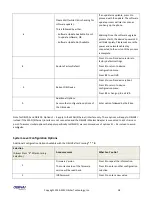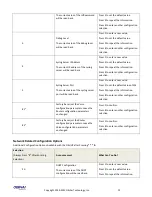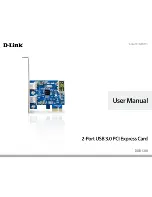
Copyright 2010-2013 Obihai Technology, Inc.
16
Use the following URLs on a web browser to launch the OBi File Explorer:
For anonymous level access: http://<OBi-IP-Address>/obi_share/anonymous
For admin or user level access: http://<OBi-IP-Address>/obi_share
The File Explore can be launched from either the WAN or LAN side of the OBi. The WAN side access can be disabled in the
configuration.
IP Routing and LAN Switching Features (OBi202 and OBi302 Only)
OBi202 and OBi302 have two Ethernet ports labelled as the Internet port and the LAN port. The OBi works as a router by
default. All the native voice services and features use the WAN port only when the OBi202/OBi302 is in router mode. The
OBi can also be set to work as a 3-port switch (a.k.a. Bridge mode), by changing its OperationMode parameter from Router
to Bridge. Note: One of the switch ports is for OBi202/OBi302 internal use only.
IP Routing Features
In router mode we refer to the network connected to the OBi Internet Port as the WAN side of the OBi202/OBi302, and the
network connected to the OBi LAN Port the LAN side of the OBi. The WAN side may be connected to another Ethernet
switch or directly to an access device such as a cable or DSL modem for Internet access. The OBi202/OBi302 routes traffic
between the LAN side and the WAN side, thus allowing the devices (such as PCs) attached to the LAN side to share Internet
access. The OBi202/OBi302 supports subnet masks as big as 255.255.255.0 to accommodate up to 253 IP addresses on its
LAN side subnet.
In addition to being a NAT (Network Address Translation) router, the OBi202/OBi302 includes a DHCP server, a DNS
forwarder and a basic firewall. It supports port forwarding, DMZ, QoS, and VLAN (802.1q). The maximum routing
throughput between the WAN and the LAN side is approximately 30 Mbps. This speed can be achieved when there are no
active calls in the system. Otherwise the throughput will be limited to a slower speed to accommodate the load for voice
processing. Note that if the WAN side is connected to an Internet access device directly, then the throughout could be
further limited by the speed of the Internet uplink and downlink.
The OBi202/OBi302 will acquire its WAN side IP address using one of the following methods: Static Address Assignment,
DHCP, or PPPoE. By default, the OBi202/OBi302 acquires its WAN side IP address using DHCP. Also by default, the
OBi202/OBi302’s own DHCP server is enabled to support LAN side clients, e.g. PCs. The default LAN side IP address of the
router is 192.168.10.1.
Incoming packets receiving from the WAN side are forwarded by the router according to the following flow:
If firewall is enabled, discard the packet if it is rejected by any one of the active firewall components
If the sending host address matches a valid entry in an internal host binding table, queue the packet for local
processing. This binding table is updated by the router with an internal algorithm.
If the sending host address matches a valid entry in an internal NAT binding table, forward the packet to the
corresponding LAN IP address. The NAT binding table is updated by the router with an internal algorithm.
If the receiving port and protocol matches a reserved pair to support an internal process (e.g. TCP Port 80 for the
OBi202 web server process), queue the packet for local processing.
If the receiving port and protocol matches a port forwarding rule, forward the packet to the LAN IP address
according to that rule.
If a DMZ host is configured, forward the packet to that LAN IP address.
Queue the packet for internal processing.
Summary of Contents for OBi100
Page 54: ...Copyright 2010 2013 Obihai Technology Inc 54...
Page 55: ...Copyright 2010 2013 Obihai Technology Inc 55...
Page 58: ...Copyright 2010 2013 Obihai Technology Inc 58...
Page 75: ...Copyright 2010 2013 Obihai Technology Inc 75...
Page 100: ...Copyright 2010 2013 Obihai Technology Inc 100...
Page 109: ...Copyright 2010 2013 Obihai Technology Inc 109 SP1 SP2 SP3 and SP4 Services...
Page 126: ...Copyright 2010 2013 Obihai Technology Inc 126...
Page 135: ...Copyright 2010 2013 Obihai Technology Inc 135...
Page 140: ...Copyright 2010 2013 Obihai Technology Inc 140...
Page 157: ...Copyright 2010 2013 Obihai Technology Inc 157...
Page 158: ...Copyright 2010 2013 Obihai Technology Inc 158...
Page 159: ...Copyright 2010 2013 Obihai Technology Inc 159...
Page 174: ...Copyright 2010 2013 Obihai Technology Inc 174...
Page 185: ...Copyright 2010 2013 Obihai Technology Inc 185...

